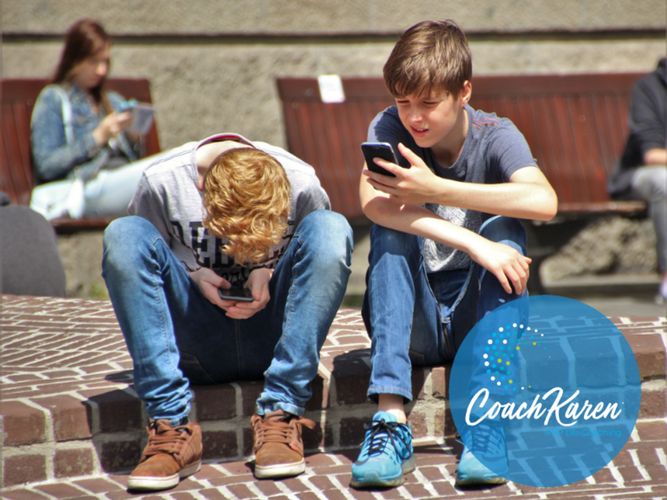When people find out I am life coach who works largely with teens, they often ask me what the biggest challenge is working with young people today. One of the biggest issues is the use and effect of technology.
And let’s be perfectly honest, this is not an issue that only effects teenagers. Today’s technology is pervasive. To function in today’s world, we all come in contact with tech.
Like most of you, a lot of what I hear about technology today is negative. I’m reminded of the July 2016 cover story by Psychology Today. The cover of that issue had a couple lying in bed with an iPad between them. The title, “Ménage à Trois: Is Tech Sabotaging Your Love Life?”
From warnings about screen time to blue light and everything in-between, it seems we often lose sight of the larger issue of taking the responsibility to manage technology in our daily lives.
What we really need to explore is how technology hinders us and how it helps us.
Hinder vs. Help
Hinder
When viewing how we are using technology, we need to ask ourselves in what way does tech get in the way of our relationships, our ability to get work done, and even our sleep.
Distraction: Giving ourselves a few minutes of play or social interaction on a pad or a phone can help relieve the stress of the day, there are lots of instances where we are distracted to the point that we hamper our ability to interact with the world around us.
This distraction can become addictive when we are continuously drawn to it and can’t get away. This is using the distraction to avoid doing other things, or to numb ourselves from something we don’t want to face.
Curbs the ability to forge real relationships: We fear that kids today will not know how to communicate and act with the physical relationships necessary to live a normal life among the rest of us. They won’t know manners or how to behave at a job or in school. And largely, they are missing out on the lessons needed to understand the nuance of physical interactions with peers, family, co-workers, and others.
Cyber-Bullying: It’s almost too easy now-a-days to act out in anger, and to really hurt others. In that moment someone can take an image and angry words and it’s quick, click, send – it’s done.
Not only that, bullying is not like it used to be. It doesn’t always favor the bigger, stronger person with a mean streak. And you can’t simply avoid a bully in the hall or on the playground. A bully can strike out literally any time day or night, or even anonymously.
Tech and driving: This includes making phone calls, texting, checking social media, even looking up directions while at the wheel. While this issue is one of distraction, the deadly possibilities warrant it being mentioned on its own.
Helps
Lest you think technology is all bad, there are plenty of instances in how beneficial it can be in our productivity and our ability to communicate and access information. But where many miss the good, is in how tech can help or aid us in our relationships.
Online dating: I hear more and more stories about people meeting online. From colleagues, to friends, and even to clients, there are a growing number of people who are finding their partners and spouses through online dating.
Connecting around the world: With today’s tech and connectedness, everyone is really only a swipe or a click away. I think back to a close friend I made in Brussells, Belgium back in 1998. After our time there, we lost touch. I moved back the states. She moved to Japan. We both got married and had children. We were just so busy. It really took FaceBook for us to reconnect and become part of each other’s lives again.
Apps beyond texting: Even gaming is more interactive than it ever has been before. I see my son and his friends wearing their headphones and playing games, but they also interact with one another as they play.
Some other apps that make relationships easier to manage are:
- GroupMe
It’s like a private chat room for your inner circle.
- MarcoPolo
It allows you to exchange video messages on the go, whether your schedules match or not.
- HouseParty
You can meet your friends for a group video chat.
- Other video conferencing apps
I really like Zoom, Skype and FaceTime.
How I began to integrate tech into my practice and my life
I started my life coaching business ten years ago. When I started, I decided to focus on teens and to only offer in-house sessions. I felt it was necessary in order to build a rapport with my clients.
At that time, it also meant I had to stay local to the San Diego area. My practice has grown to include many adult clients as well as business clients. Some went off to college or moved away. As my scope expanded, I had to find ways to support my clients. Thankfully, technology was offering solutions.
I started with Skype, as a way to video conference my appointments. Since then, clients have continued to introduce other apps to keep in touch. Facetime, Google Hangouts, and my favorite, Zoom are a regular part of my sessions.
Being able to talk face-to-face is vitally important for rapport, as well as creating a close connection with them.
I had one client who had spent much of her youth in the Pageant world. She realized that a large part of her life was centered on appearance. She had to be completely put together at all times. Hair, makeup, stylish clothing, and a big smile, and that was just to go work out!
Having an option to go onto Zoom, to keep her appointment with me and not go through that was liberating for her. It allowed her to relax. She even had a towel around her head once. We’d both show up with no makeup, or even wearing a baseball cap. We just got real with each other.
Another app I have really come to like is MarcoPolo. It is a great way to be involved with a client between sessions. They can just shoot me a short video, and I can give a short response. It enables me to see, hear and read all those non-verbal cues that add to the conversation.
It’s proven a great way to:
- Celebrate victories
- Tell me about challenges they’re facing
- Or even just to vent
What can you do build healthy relationships aided by tech and with tech?
Technology isn’t going anywhere. Our need to have fulfilling and healthy relationships in this technological world is as strong as ever. We need to make sure that we are using our devices to help our relationships, not hinder them.
To do this we need to do three things with the technology in our lives. Assess, Challenge, and Support.
Assessment
Think about the relationships you have in your life. How do you interact with that person regularly? Does tech play a part? Does it help or hinder? How so?
Challenge
What are those ways in which the tech isn’t working? Which technology is hindering your ability to have a healthy relationship with that person. Think of ways to challenge yourselves to work through the technology.
I’m currently on Day 7 of a “Turning Off Notifications” challenge. Essentially, I turned off every notification on my phone.
I’ll admit that on Day One, I went into full-on FOMO mode. (For the uninitiated, that’s Fear Of Missing Out.) I checked phone every 10 minutes. When I realized this, it made me assess what technology was in my life.
As the days progressed, I continued to assess my usage. I realized I really only checked five apps regularly.
So, now. I know which are most important. This challenge focused me on what tech I used and needed most.
Support
What actions or resources can you use to help build healthy relationships…with healthy uses of tech?
Looking at my assessment of my “Turn Off Notifications” challenge, I’ve decided to change my notification settings. I will not put notifications back for all five of my regular apps. Instead, phone calls and texts will be the only notifications I get. Largely, because I need to have contact with family and clients in case of emergencies.
For the other three, I will block of time daily for reviewing them. I will put them into the parts of my day that make sense. Email is something I had already changed my approach to. I check emails in the morning and in the evening. That’s it. There is rarely an email that is so urgent it requires an immediate response.
Some other examples of support measures you can take:
No toys at the table: I always told my children they could not bring their LEGOs and dolls and such to the dinner table. But slowly, our cell phones made their way in. In fact, my husband and I brought ours first, and the kids followed suit. In our house, or in a restaurant, no phones are allowed while we’re eating.
Stacking: This is a fun way to encourage you and your friends to lose the phones when you’re out. Take all your phones and stack them up in the middle of the table. The first person who grabs their phone, pays for everyone!
Pay attention in the front seat: My youngest son is learning to drive. So, I’ve implemented a no-phone while in the front seat rule. This allows him to be an active participant while I drive. As things occur, I point out to him different situations, how I react to them, and ask what he notices going on around him. As an added bonus, it forces us to interact with each other, and I find that we have a lot of meaningful conversation as a result.
Tech and sleep don’t mix: Turn off all your tech 30 minutes before you go to sleep. There are loads of studies pointing to how technology, EMF’s in particular, disrupt sleep. Giving yourself time to wind down and prepare for bed can help the quality of your sleep. In fact, I go one step further. There’s no screens in our bedrooms. Televisions can be just as disruptive as an iPad.
Set clear times for use: When I first started my practice, and I’m sure this is true for many entrepreneurs out there as well, I worked all the time. I was on my computer in the morning until almost bed time. This was disruptive to my whole family. What we settled on was a 5 pm deadline for powering down. There were special circumstances on Wednesdays, but it became a part of the schedule.
Set an absolute schedule for when you must be done for the day and stick to it.
Change the format: If you find that you interact with someone on only on one app or in only one way, try moving to different technology, or a different app. For instance, if you game with someone on a regular basis, try exchanging video message on MarcoPolo. Make it more of a face-to-face interaction. If there’s a group of you, try all meeting on HouseParty.
You can always be completely radical and old-fashioned and make a phone call or meeting for a coffee. And if you’re just not comfortable speaking around people, you can try Toastmasters to build up your conversational skills.
Overall, technology itself is not unhealthy, but our use of it can be. It is up to us to assess, challenge, and choose how we use it to best serve our relationships with others.





















